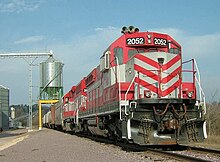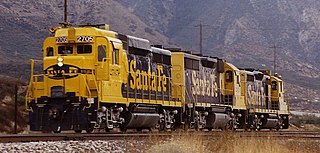
The EMD GP30 is a 2,250 hp (1,680 kW) four-axle diesel-electric locomotive built by General Motors Electro-Motive Division of La Grange, Illinois between July 1961 and November 1963. A total of 948 units were built for railroads in the United States and Canada, including 40 cabless B units for the Union Pacific Railroad.

The E8 was a 2,250-horsepower (1,678 kW), A1A-A1A passenger-train locomotive built by General Motors' Electro-Motive Division (EMD) of La Grange, Illinois. A total of 450 cab versions, or E8As, were built from August 1949 to January 1954, 447 for the U.S. and 3 for Canada. 46 E8Bs were built from December 1949 to January 1954, all for the U.S. The 2,250 hp came from two 12 cylinder model 567B engines, each driving a generator to power the two traction motors on one truck. The E8 was the ninth model in the line of passenger diesels of similar design known as EMD E-units. Starting in September 1953, a total of 21 E8As were built which used either the 567BC or 567C engines.

The E9 is a 2,400-horsepower (1,790 kW), A1A-A1A passenger train-hauling diesel locomotive built by General Motors' Electro-Motive Division of La Grange, Illinois, between April 1954 and January 1964. 100 cab-equipped A units were produced and 44 cabless booster B units, all for service in the United States. The E9 was the tenth and last model of EMD E-unit and differed from the earlier E8 as built only by the newer engines and a different, flusher-fitting mounting for the headlight glass, the latter being the only visible difference. Since some E8s were fitted with this, it is not a reliable way to distinguish the two. The E9 has two 1,200 hp (895 kW), V12 model 567C engines, each engine driving one generator to power two traction motors.

The EMC E2 was an American passenger-train diesel locomotive which as a single unit developed 1,800 horsepower (1,300 kW), from two (2) 900 horsepower (670 kW) prime movers. These locomotives were typically operated as a unit set or ; where the three unit lashup developed 5400 horsepower. This was almost the ideal horsepower required for the tonnage of a 15 - 18 car passenger train, operated over the ruling grades of virtually all of the mileage between major American cities. The units were of the A1A-A1A wheel arrangement, and manufactured by Electro-Motive Corporation (EMC), later Electro-Motive Diesel (EMD) of La Grange, Illinois.
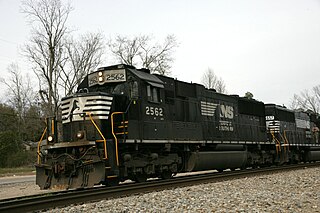
The EMD SD70 is a series of diesel-electric locomotives produced by the US company Electro-Motive Diesel in response to the GE Dash 9-44CW. Production commenced in late 1992 and since then over 5,700 units have been produced; most of these are the SD70M and SD70MAC models. While the majority of the production was ordered for use in North America, various models of the series have been used worldwide. All locomotives of this series are hood units with C-C trucks, except the SD70ACe-P4 which has a B1-1B wheel configuration, and the SD70ACe-BB, which has a B-B-B-B wheel arrangement.

The EMD SD90MAC is a 6,000 hp (4,470 kW) C-C diesel-electric locomotive produced by General Motors Electro-Motive Division. It is, with the SD80MAC, one of the largest single-engined locomotives produced by EMD, surpassed only by the dual-engined DDA40X.

The EMD SW1 is a 600-horsepower (450 kW) diesel-electric switcher locomotive built by General Motors' Electro-Motive Corporation between December 1938 and November 1953. Final assembly was at EMD's plant at LaGrange (McCook) Illinois. The SW1 was the second generation of 3,402 cu in (55.75 L) switcher from EMD, succeeding the SC and SW. The most significant change from those earlier models was the use of an engine of EMD's own design, the then-new 567 engine, here in 600 hp (450 kW) V6 form. 661 locomotives of this design were built, with a gap in production between March 1943 and September 1945 due to World War II.

The EMD SD40-2 is a 3,000-horsepower (2,200 kW) C-C diesel-electric locomotive built by EMD from 1972 to 1989.
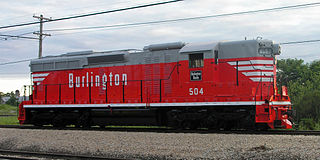
The EMD SD24 was a 2,400 hp (1,800 kW) six-axle (C-C) diesel-electric locomotive built by General Motors' Electro-Motive Division of La Grange, Illinois between July 1958 and March 1963. A total of 224 units were built for customers in the United States, comprising 179 regular, cab-equipped locomotives and 45 cabless B units. The latter were built solely for the Union Pacific Railroad.

The EMD GP7 is a four-axle (B-B) diesel-electric locomotive built by General Motors Electro-Motive Division and General Motors Diesel between October 1949 and May 1954.

The EMD GP9 is a four-axle diesel-electric locomotive built by General Motors' Electro-Motive Division between 1954 and 1959. The GP9 succeeded the GP7 as the second model of EMD's General Purpose (GP) line, incorporating a new sixteen-cylinder engine which generated 1,750 horsepower (1.30 MW). This locomotive type was offered both with and without control cabs; locomotives built without control cabs were called GP9B locomotives.

An SD9 is a 6-axle diesel locomotive built by General Motors Electro-Motive Division between January 1954 and June 1959. An EMD 567C 16-cylinder engine generated 1,750 horsepower (1.30 MW). Externally similar to its predecessor, the SD7, the SD9 was built with the improved and much more maintainable 567C engine.

The EMD SD40 is an American 6-axle diesel-electric locomotive built by General Motors Electro-Motive Division between January 1966 and August 1972. 1,268 locomotives were built between 1966 and 1972. In 1972, an improved version with new electronics was developed and marketed as a new locomotive, the SD40-2.

The SD45 is a six-axle diesel-electric locomotive built by General Motors Electro-Motive Division between 1965 and 1971. It has an EMD 645E3 twenty-cylinder engine generating 3,600 hp (2,680 kW) on the same frame as the SD38, SD39, SD40, and SDP40. As of 2022, most SD45s have been retired, scrapped or rebuilt to SD40-2 standards.

The SD20-2 was a type of diesel-electric locomotive created in 1979/1980 by the Baltimore and Ohio Railroad by rebuilding EMD SD35 locomotives. Five of the B&O's SD35 fleet were rebuilt at their Cumberland Yard by fitting a non-turbocharged EMD 645 engine and upgraded electrical systems. They were placed in service at the B&O Queensgate Yard in Cincinnati, Ohio attached to slugs, engineless units with traction motors that draw their power from the "mother" unit.

The EMD GP16 are a series of rebuilt diesel-electric locomotives, a result of a remanufacturing program initiated by the Seaboard Coast Line Railroad (SCL) in an effort to spare the cost of purchasing new motive power in the late 1970s. This involved the rebuilding of their aging fleet of EMD GP7, GP9 and GP18 road switchers. 155 locomotives were rebuilt by the SCL.

The EMD GP10 is a diesel-electric locomotive that is the result of rebuilding a GP7, GP9 or GP18.

An EMD GP49 is a 4-axle diesel locomotive built by General Motors Electro-Motive Division. Power was provided by an EMD 645F3B 12-cylinder engine which generated 2,800 horsepower (2.09 MW). The GP49 was marketed as one of four models in the 50 series introduced in 1979. The 50 series includes GP/SD49 and GP/SD50. Both the GP and SD50 was relatively popular with a total of 278 GP50s and 427 SD50s built. The SD49 was advertised but never built and a total of 9 GP49s were built.
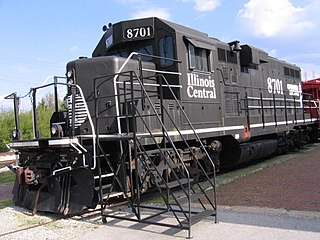
The EMD GP11 is a four-axle diesel locomotive rebuilt by the Illinois Central Railroad's Paducah shops. It is very similar in appearance to the GP8 and GP10.

A B unit, in railroad terminology, is a locomotive unit which does not have a control cab or crew compartment, and must therefore be operated in tandem with another coupled locomotive with a cab. The terms booster unit and cabless are also used. The concept is largely confined to North America. Elsewhere, locomotives without driving cabs are rare.
